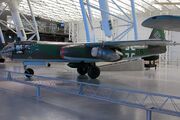Only one Ar 234 survives today. The aircraft is an Ar 234 B-2 bomber variant carrying Werknummer

Ar 234 B-2 140312
(manufacturer's serial number) 140312, and was one of nine Ar 234s surrendered to British forces at Sola Airfield near Stavanger, Norway. The aircraft had been operating with 9. staffel III./Kampfgeschwader 76 (later reorganised as Einsatzstaffel) during the final weeks of the war, having operated previously with the 8th squadron. This aircraft and three others were collected by the famous "Watson's Whizzers" of the USAAF to be shipped back to the United States for flight testing. The aircraft was flown from Sola to Cherbourg, France on June 24, 1945 where it joined thirty-four other advanced German aircraft shipped back to the U.S. aboard the British aircraft carrier HMS Reaper. The Reaper departed Cherbourg on July 20, arriving at Newark, New Jersey eight days later. Upon arrival two of the Ar 234s were reassembled (including 140312) and flown by USAAF pilots to Freeman Field, Indiana for testing and evaluation. 140312 was assigned the foreign equipment number FE-1010. The fate of the second Ar 234 flown to Freeman Field remains a mystery. One of the remaining two was reassembled by the U.S. Navy for testing, but was found to be in unflyable condition and was scrapped.Template:Fact
After receiving new engines, radio and oxygen equipment 140312 was transferred to Wright Field near Dayton, Ohio and delivered to the Accelerated Service Test Maintenance Squadron (ASTMS) of the Flight Test Devision in July 1946. Flight testing was completed on October 16, 1946 though the aircraft remained at Wright Field until 1947. It was then transferred to Orchard Place Airport, Park Ridge, Illinois, and remained at Orchard Place Airport until May 1, 1949 when it, and several other aircraft stored at the airport were transferred to the Smithsonian Institution. During the early 1950s the Ar 234 was moved to the Smithsonian's Paul Garber Restoration Facility at Suitland, Maryland for storage, and eventual restoration.
The Smithsonian began restoration of Ar 234 B-2 140312 in 1984 and completed it in February, 1989. All paint had been stripped from the aircraft prior to the Smithsonian receiving it, so the aircraft was painted with the markings of an aircraft of 8./KG 76, the first operational unit to fly the "Blitz". The restored aircraft was first displayed at the Smithsonian's main museum building in downtown Washington D.C. in 1993 as part of a display titled "Wonder Weapon? The Arado Ar 234." In 2005 it became one of the first aircraft moved to the new Steven F. Udvar-Hazy Center near Dulles International Airport. Today 140312 is displayed next to the last surviving Dornier Do 335, an aircraft that had accompanied it on its voyage across the Atlantic Ocean aboard the Reaper over sixty years earlier.
This aircraft is displayed with a pair of Hellmuth Walter designed, liquid-fueled RATO units mounted under its wings. These RATO units may be the only known surviving examples in existence.
More information[]
There is a photograph of 140312 on page 98 of the reprinted edition of Captain Eric Brown's book Wings of the Luftwaffe. The caption for the photograph describes 140312 as an Ar 234B-1/b, and states the aircraft was - allegedly - acquired at Saalbach, and was presumed to have been on the strength of1./FAGr.110, which performed reconnaissance missions under Luftflotte 6 during the closing months of the war in Europe.[1]
This article includes material from http://en.wikipedia.org/wiki/Arado_Ar_234. It is republished here under the Gnu Free Documentation Licence.
References[]
- ↑ "Reprint of Wings Of the Luftwaffe by Eric Brown, published 2001 by Airlife Publishing Ltd. ISBN 1-85310-413-2
